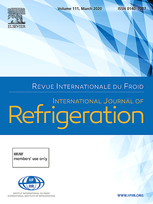
Summary
The hollow fiber membrane energy accumulator (HFMEA) and the flat membrane energy accumulator (FMEA) were designed. Dynamic mathematic models of the heat and mass transfer in the full-scale membrane energy accumulators (MEAs) were built in order to consider the membrane-to-membrane interactions and boundary effect in MEAs. The reliability of mathematic models has been verified by the experimental results. The maximum relative deviations of the mass transfer flux and solution temperature were 14.9 % and 14.6 %, respectively. The change rate of LiBr mass fraction in the FMEA was 1.38 times of that in the HFMEA. The hollow fiber membrane bundle in HFMEA is more conducive to the mass transfer process when the arrangement of the fibers is triangular. When the length of the membrane channel increased from 50 mm to 160 mm in HFMEA, the mass transfer per membrane surface area decreased by about 5 %. With increasing the vapor inlet pressure from 700 Pa to 1500 Pa, the mass transfer flux was tripled. And the average temperature of the solution increased by more than 3.75°C in 10 minutes. If the membrane filled density increased from 1.4 % to 2.1 %, the mass transfer flux increased to 2.04 times in FMEA.
Available documents
Format PDF
Pages: 874-886
Available
Public price
20 €
Member price*
Free
* Best rate depending on membership category (see the detailed benefits of individual and corporate memberships).
Details
- Original title: Comparative analysis of energy discharge characteristics between hollow fiber membrane and flat membrane energy accumulators.
- Record ID : 30029191
- Languages: English
- Subject: Technology
- Source: International Journal of Refrigeration - Revue Internationale du Froid - vol. 131
- Publication date: 2021/11
- DOI: http://dx.doi.org/10.1016/j.ijrefrig.2021.07.042
- Document available for consultation in the library of the IIR headquarters only.
Links
See other articles in this issue (95)
See the source
-
Experimental research on heat and mass transfer...
- Author(s) : SUN S., ZHANG Q., SONG Q., WANG D., LI Y., KONG X.
- Date : 2021/08
- Languages : English
- Source: International Journal of Refrigeration - Revue Internationale du Froid - vol. 128
- Formats : PDF
View record
-
Global modeling of heat and mass transfers in s...
- Author(s) : BEN HAFSIA N., CHAOUACHI B., GABSI S.
- Date : 2014/02
- Languages : English
- Source: International Journal of Refrigeration - Revue Internationale du Froid - vol. 38
- Formats : PDF
View record
-
Transient model for the development of an air-c...
- Author(s) : CASTRO J., FARNOS J., PAPAKOKKINOS G., ZHENG J., OLIET C.
- Date : 2020/12
- Languages : English
- Source: International Journal of Refrigeration - Revue Internationale du Froid - vol. 120
- Formats : PDF
View record
-
Intercambiador de calor con membrana de fibra h...
- Author(s) : WANG Z., FENG S., LI Y., et al.
- Date : 2009/05
- Languages : Spanish
- Source: Frío Calor Aire acondicionado - vol. 37 - n. 414
- Formats : PDF
View record
-
Numerical simulation of Marangoni convection wi...
- Author(s) : GIANNETTI N., YAMAGUCHI S., SAITO K.
- Date : 2018/08
- Languages : English
- Source: International Journal of Refrigeration - Revue Internationale du Froid - vol. 92
- Formats : PDF
View record
